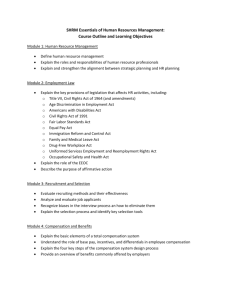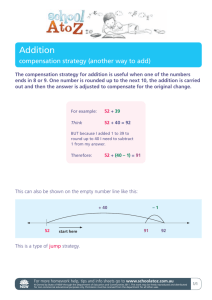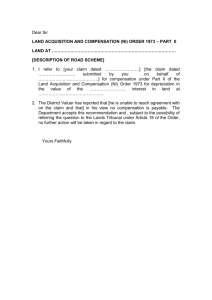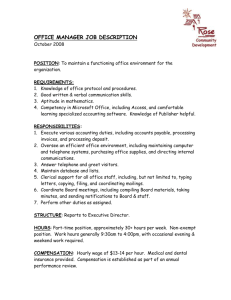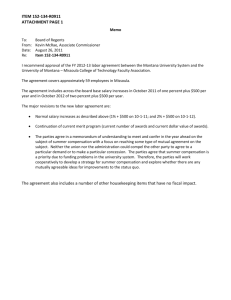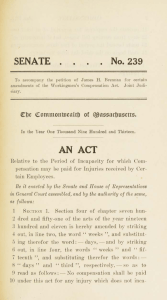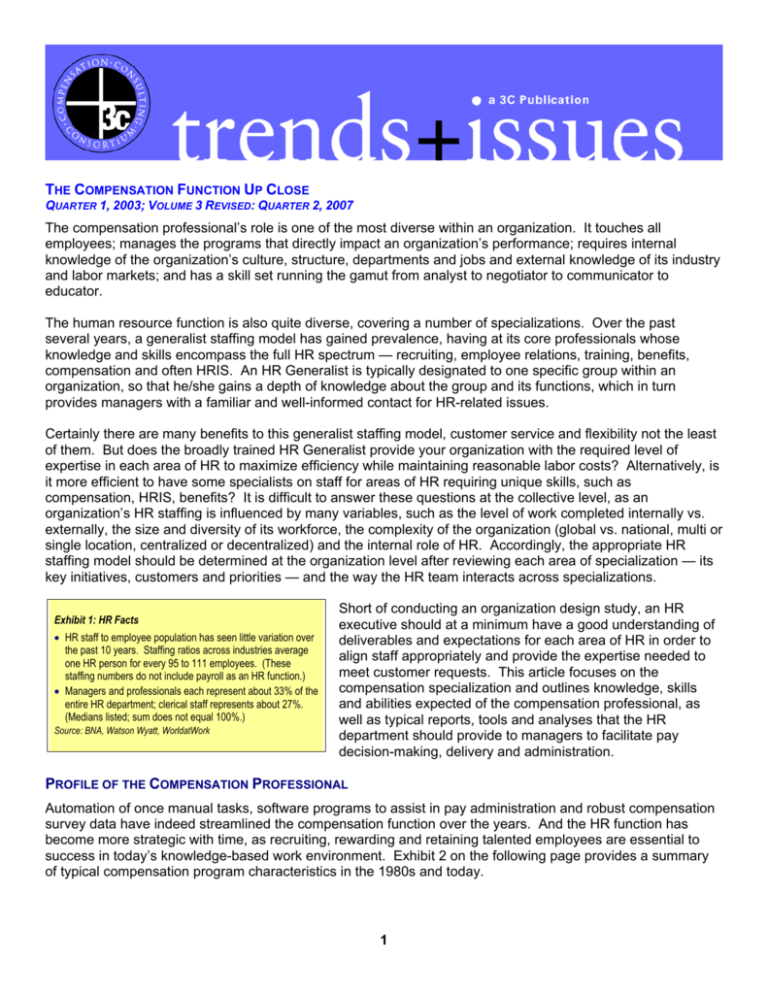
THE COMPENSATION FUNCTION UP CLOSE
QUARTER 1, 2003; VOLUME 3 REVISED: QUARTER 2, 2007
The compensation professional’s role is one of the most diverse within an organization. It touches all
employees; manages the programs that directly impact an organization’s performance; requires internal
knowledge of the organization’s culture, structure, departments and jobs and external knowledge of its industry
and labor markets; and has a skill set running the gamut from analyst to negotiator to communicator to
educator.
The human resource function is also quite diverse, covering a number of specializations. Over the past
several years, a generalist staffing model has gained prevalence, having at its core professionals whose
knowledge and skills encompass the full HR spectrum — recruiting, employee relations, training, benefits,
compensation and often HRIS. An HR Generalist is typically designated to one specific group within an
organization, so that he/she gains a depth of knowledge about the group and its functions, which in turn
provides managers with a familiar and well-informed contact for HR-related issues.
Certainly there are many benefits to this generalist staffing model, customer service and flexibility not the least
of them. But does the broadly trained HR Generalist provide your organization with the required level of
expertise in each area of HR to maximize efficiency while maintaining reasonable labor costs? Alternatively, is
it more efficient to have some specialists on staff for areas of HR requiring unique skills, such as
compensation, HRIS, benefits? It is difficult to answer these questions at the collective level, as an
organization’s HR staffing is influenced by many variables, such as the level of work completed internally vs.
externally, the size and diversity of its workforce, the complexity of the organization (global vs. national, multi or
single location, centralized or decentralized) and the internal role of HR. Accordingly, the appropriate HR
staffing model should be determined at the organization level after reviewing each area of specialization — its
key initiatives, customers and priorities — and the way the HR team interacts across specializations.
Exhibit 1: HR Facts
• HR staff to employee population has seen little variation over
the past 10 years. Staffing ratios across industries average
one HR person for every 95 to 111 employees. (These
staffing numbers do not include payroll as an HR function.)
• Managers and professionals each represent about 33% of the
entire HR department; clerical staff represents about 27%.
(Medians listed; sum does not equal 100%.)
Source: BNA, Watson Wyatt, WorldatWork
Short of conducting an organization design study, an HR
executive should at a minimum have a good understanding of
deliverables and expectations for each area of HR in order to
align staff appropriately and provide the expertise needed to
meet customer requests. This article focuses on the
compensation specialization and outlines knowledge, skills
and abilities expected of the compensation professional, as
well as typical reports, tools and analyses that the HR
department should provide to managers to facilitate pay
decision-making, delivery and administration.
PROFILE OF THE COMPENSATION PROFESSIONAL
Automation of once manual tasks, software programs to assist in pay administration and robust compensation
survey data have indeed streamlined the compensation function over the years. And the HR function has
become more strategic with time, as recruiting, rewarding and retaining talented employees are essential to
success in today’s knowledge-based work environment. Exhibit 2 on the following page provides a summary
of typical compensation program characteristics in the 1980s and today.
1
Exhibit 2. The compensation function has experienced significant change over the past 20 years. Here is a before/after
analysis of compensation programs, a view from the early 1980s (before) and early 2000s (now).
ITEM
BEFORE
NOW
Administration
• Compensation administration and analyses were
paper-intensive
• Reports and analyses were typically run from
organization’s mainframe computer system
• Little use of online tools for managers
• Compensation administration and analyses are
typically PC-based
• A multitude of HR software systems are available
that seamlessly interface with the organization’s IT
system
• Online tools for managers are common
Base Pay
• Employees tended to invest a significant amount
of time at one employer
• Internal equity took precedence over external
competitiveness
• Analysis of job by compensable factor and focus
on equity in pay across disciplines
• Employees likely to have held a number of jobs by
the end of their careers
• External pay focus is of primary importance
• Whole job review, not component-by-component
review
• Equity tends to be established and maintained
within a discipline, consistent with how the market
moves
Short-term incentive
• Incentive pay was reserved for the top tier of the
organization
• Easier to link individual contribution to results,
given participants’ direct influence over such
results
• Communication was to select group and less
formal compared to today
• Variable pay’s role in influencing performance at all
levels has been elevated
• Widespread use of broad incentive plans covering
all or most employee groups
• Effective “line of sight” communication to engage
and focus employees on their contribution to overall
goals is considered key to plan’s success
Long-term incentive
• LTI plans rarely reached below the top
management level
• LTI portion of total reward was not as significant
as it is today
• Less widespread use of LTI meant fewer issues
related to stock dilution, underwater options and
appropriate reward levels
• Less focus on sharing organizational
performance objectives and practices; less
education provided to eligible employees
• Broad-based stock option programs are common
• LTI is significant portion of total reward package for
executives and managers
• Organizations seek appropriate balance between
LTI and other pay components.
• FASB 123 stock option expensing is timely topic
• Enhanced organizational training and education to
assist employees in understanding how they affect
overall results
Performance management
• Main focus was the end of the year performance
evaluation and goal-setting for upcoming year
• Salary increase budgets were higher (6% of
payroll and above) due to inflation, as well as
less frequent use of incentive pay
• Employee performance goals were not often
linked to corporate goals
• End of year evaluation considered a culminating
event following a year-long cycle of ongoing
feedback and coaching
• Annual salary increase budgets hover around 3.5%
to 4% of payroll
• Link between employee and corporate goals and
performance are typically established at the
beginning of the performance year
Executive Compensation
• Executive compensation decisions and
administration often made outside the HR
department
• HR typically accountable for executive
compensation
2
Compensation KSAs
As expected, the compensation professional’s Knowledge, Skills and Abilities (KSAs) have also evolved with
time to be more consultative, technical and business-focused, while strong analytical skills and in-depth
compensation knowledge have always been essential. Typical KSAs required of a compensation professional
having three to five years of experience are listed below.
Compensation Knowledge
• Compensation principles. While an effective compensation system is somewhat unique in that it is directly
linked to an organization’s culture and goals and objectives, a compensation professional should be
knowledgeable of key principles for compensation design and administration across the organization, best
practices, typical salary structure and budget movement from one year to the next, financial modeling and
effective communication tools.
• Laws and legislature impacting compensation. Compensation professionals should have a solid
understanding of the impact and application of laws and regulations covering employee compensation.
These range from long-existing laws ─ like the Fair Labor Standards Act of 1938 (FLSA) that establishes the
minimum wage, overtime pay requirements and child labor laws ─ to new legislation, such as the SarbanesOxley Act of 2002 that established the Public Company Accounting Oversight Board to oversee audits of the
financial statements of public companies. If the organization operates on a global level, knowledge of
legislation affecting employee compensation in other countries is also required.
• Benefits and tax issues. Benefits and compensation overlap frequently, so it is important that the
compensation professional has an understanding of the organization’s benefit programs and legal
implications that could arise related to compensation program design or decisions. In addition, knowledge of
tax issues related to pay is necessary.
Internal Knowledge
• Organization. Understanding an organization’s products and services, financials, compensation programs
and its various departments and their interrelationships is a requisite. If the organization is very large or has
a complicated structure, a compensation professional might be responsible for one or two designated areas.
In this case, knowledge of the organization’s core jobs and functions is still important.
• Jobs. This complements organization knowledge. A thorough understanding of jobs and how they fit into the
organization is critical to valuing them appropriately and advising managers. Organization structures should
be kept up to date and as uncomplicated as possible. A list of market-sensitive (hard to fill) jobs, along with a
strategy to address them, should be established and updated quarterly.
• Systems and databases. Proficiency with the systems and databases that the organization uses to manage
its compensation programs is essential.
3
External Knowledge
• Industry. Each industry has its own intricacies, standards and eminent organizations that set the pace for the
others. Networking and establishing contacts within the same industry are well worth the time. (But direct
sharing of pay data can lead to charges of price fixing or collusion, so it is best to use third party-based
compensation surveys.)
• Market surveys and data sources. Even if the organization’s base pay system is not primarily market-based,
external market data is still required to gauge competitiveness and align the internal system with external pay
rates in order to attract and retain employees. Surveys vary in scope and quality; a compensation
professional should know the available sources and the various methodologies used to collect and display
data. Survey sources used to gauge external pay levels must be credible and relevant to the organization. In
addition, several survey sources should be used to thoroughly assess changes in market pay practices.
• Labor markets. An organization competes for talent in many labor markets – geographic, industry, and
organization size are the most prevalent. Labor markets will vary by employee level and job; they will also
change over time. The compensation professional must be aware of labor market conditions impacting the
recruitment and retention of employees throughout the organization and also understand the cost of labor for
the same jobs located in different geographic areas. (This is typically presented as a geographic differential.)
• Performance Expectations. Understanding the organization’s and specific department’s business strategy,
goals and performance expectations is critical to understanding the appropriate level of cash compensation
investment – base pay and variable pay – required to attract, retain and motivate staff. If performance
expectations are only at the 25th percentile of peer practices, for example, compensation levels would
typically not need to be at the 75th percentile.
Skills and Abilities
• Mathematical and analytical: to complete ongoing analyses and program modeling
• Technical: spreadsheet and database proficiency (understanding of current systems and ability to readily
pick up the skills and knowledge necessary to understand new systems)
• Communication skills: ability to write succinctly and for the intended audience; good presentation skills
• Independent judgment: ability to reason through data and findings and use good judgment in making
recommendations concerning internal application of such information
• Negotiation: ability to see two sides of a situation and compromise when appropriate
4
COMPENSATION REPORTS AND ANALYSES
Reports and analyses that should be provided by a compensation department are outlined below according
to the typical time period in which the report is produced.
Quarterly or More Frequent
Report
Purpose
Employee turnover analysis
Employee turnover from one time period to the next presented for the whole organization and by
department/group. Follow-up analyses for high turnover areas to uncover the root cause
Cost of turnover
Summary of expense associated with hiring employees (recruiting fees, interview time, testing, cost of job
ads, lost productivity and other) multiplied by the number of new hires during the quarter
Range analysis
Comparison by incumbent of salary range position and targeted position based on performance and other
important factors to determine the gap between the two
Diversity analysis
Comparison of pay, merit increases and incentive payouts to protected classes of employees (female,
minority, age 40 or over) vis-à-vis all other employees
Overtime analysis
Review by department of overtime hours worked by employees and the cost of such overtime to determine
whether staffing additions are justified
Market-sensitive job review
Outline of hard-to-fill jobs and special pay deals offered on a temporary basis to retain incumbents
Incentive plan performance
analysis and communication
Analysis of year-to-date performance against incentive goals followed by employee communication update
Annual
Report
Purpose
Market analysis
Update of market data for a group of benchmark jobs to determine changes in pay from year to year
Geographic analysis
Analysis/update of the cost of labor for each location as a percentage of the national average
Salary structure and budget
analysis
Analysis of market salary structure adjustments and salary budget adjustments followed by
recommendations for the internal structure adjustment and pay increase budget
Rating analysis/pay adjustment
analysis
Review of performance ratings and requested salary adjustments by department to ensure budget is met
FLSA classification review
Random FLSA audit of a small group of jobs, including employee and manager interviews or desk audit to
determine accuracy of job description
Total compensation analyses
Review in growth of total compensation expense from an absolute perspective as well as per employee to
assist in monitoring staffing levels; analyses should include comparisons of total compensation expense
vis-à-vis revenue per employee to view the potential return on compensation investments
Top performer analyses
Also frequently referred to as HIPO analyses; a review of pay increases, promotions, bonuses, and other
compensation components for the organization’s top performers to ensure retention but more importantly
additional growth in these valuable assets
5
As Needed or Requested
Report
Purpose
FLSA testing
Determination of exempt or nonexempt classification as jobs are changed or created
Market analysis
Market analysis to determine the external rate of pay for new or changed jobs
Special pay analysis by
department, group
Various pay analyses upon request (internal pay compared to market, difference between lowest and
highest paid person in a select job, analysis of pay level to performance level and others)
MANAGER TOOLS
In addition to reports and analyses, progressive HR departments provide the following tools to managers to
assist in compensation administration:
• On-line job descriptions and performance evaluation: Forms should be straightforward and easy to
complete
• FLSA testing tools: Questionnaire for executive, professional, administrative, sales and computer-related
FLSA exemption tests
• Merit matrix modeler: Tool managers can use to enter performance ratings and projected annual pay
adjustments to determine overall pay adjustment compared to budget and performance rating distribution
• Incentive pay modeler: Tool managers can use to view employees’ total cash compensation opportunity,
performance and reward linkages and incentive allocations
• Target pay rate: Internal or external values for the department’s jobs updated annually
• Job families: or career ladders that array the jobs within a discipline from low to high in terms of duties,
responsibilities and pay and provide thumbnail descriptions of each job. (See Compensation example as
Exhibit 3 on the next page.)
• Range placement: Guidelines for placing employees in the appropriate salary range position based on
performance, current pay level against target, skills and other factors.
• Pay administration: Guidelines for administering the pay program, including typical pay adjustments for
promotions, demotions and lateral moves; process for approval of exceptions; special pay deals for hard to
fill jobs, and related items.
6
COMPENSATING THE COMPENSATION STAFF
The following chart outlines a typical career family for the compensation function, including median annual
base salary and total cash compensation (base plus annual incentive) levels at the national, all-industry level
and typical education and experience levels.
EXHIBIT 3: COMPENSATION JOB FAMILY
ÍÍEXPERIENCE, KNOWLEDGE, SKILLS, RESPONSIBILITIES ÎÎ
HR Assistant, Associate
Compensation Analyst,
Associate
Compensation Analyst,
Senior
Compensation Manager
Top Compensation
Position
Base: $33,300
TC: $33,700
High school,
Base: $47,300
TC: $48,500
Bachelor’s degree,
Base: $70,000
TC: $73,000
Bachelor’s degree,
Base: $95,600
TC: $105,400
Bachelor’s degree,
Base: $145,000
TC: $176,600
Bachelor’s degree,
One to two years admin
experience
Two to four years of
experience
Four or more years of
experience
Seven to 10 years of
experience
10 plus years of
experience
Source: William Mercer 2006 Human Resource Management Report, 3C analysis
IN CLOSING
Many organizations continue to tow the line financially, while they also seek creative approaches to keep
employees satisfied and improve performance on all fronts. This situation presents tremendous challenges
and opportunities to the Human Resources department and will continue to provide the compensation
professional with interesting and important assignments. As such, the KSAs outlined in this document are
sure to evolve over time in order to meet the organization’s changing needs.
Copyright 2007 by 3C. All rights reserved.
For more information, please contact:
Lisa.Audi@3Ccomp.com
Dawn.Cumpston@3Ccomp.com
Brian.Enright@3Ccomp.com
Mark.Reilly@3Ccomp.com
7

